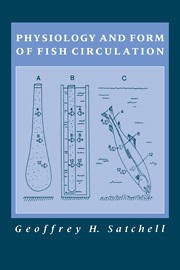Book contents
- Frontmatter
- Contents
- Preface
- 1 Introduction
- 2 The Heart
- 3 The peripheral circulation
- 4 The blood
- 5 Haemopoiesis and phagocytosis - the mononuclear phagocytic system
- 6 Circulation through special regions
- 7 Retial counter-current systems: flow–diffusion–concentration
- 8 Venous return and venous pumps
- 9 The autonomic nervous system
- 10 The response to exercise
- 11 The response to hypoxia
- 12 Myxine, a speculative conclusion
- References
- Appendix of popular and scientific names
- Index
1 - Introduction
Published online by Cambridge University Press: 05 February 2012
- Frontmatter
- Contents
- Preface
- 1 Introduction
- 2 The Heart
- 3 The peripheral circulation
- 4 The blood
- 5 Haemopoiesis and phagocytosis - the mononuclear phagocytic system
- 6 Circulation through special regions
- 7 Retial counter-current systems: flow–diffusion–concentration
- 8 Venous return and venous pumps
- 9 The autonomic nervous system
- 10 The response to exercise
- 11 The response to hypoxia
- 12 Myxine, a speculative conclusion
- References
- Appendix of popular and scientific names
- Index
Summary
Fish are the largest class of vertebrates; with over 21000 existing species they outnumber the amphibians, reptiles, birds and mammals put together. Fish span a long period of geological time for the earliest hagfish are now believed to have arisen in the Cambrian period, (Hardisty 1982). As inhabitants of both salt and fresh water they are spread over 71% of the earth's surface. The greatest depths of the oceans are deeper than the world's highest mountains, so fish span a greater vertical range than air-breathing vertebrates. For this reason they endure a larger range of pressures; on land the pressure at 9000 m is 0.3 atm but in the greatest depths of the oceans it is 1200 atm. They can live continuously in waters of extreme temperature. Some of the Chaenichthydae live permanently below the polar ice at temperatures of −1 to −1.8°C; a cichlid Oreochromis grahami lives in alkaline lakes in Kenya's rift valley, in which the water has a temperature of 43°C and a pH of 9.6–10.5 (Johansen et al. 1975). Fish have become adapted to environments quite as extreme as any occupied by higher vertebrates.
Fish, like other vertebrates, possess a circulatory system consisting of a pump, the heart, and a continuous system of branching tubes, the arteries, arterioles, capillaries and veins, which form a closed circuit so that all of the blood leaving the heart is returned to it.
- Type
- Chapter
- Information
- Physiology and Form of Fish Circulation , pp. 1 - 9Publisher: Cambridge University PressPrint publication year: 1991
- 1
- Cited by



